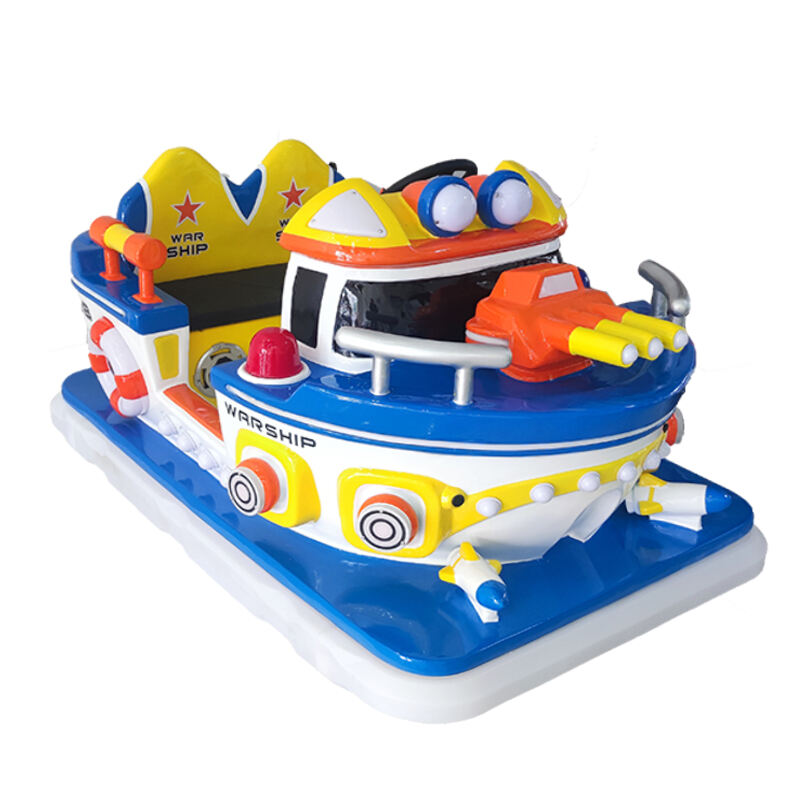ကလေးဖွံ့ဖြိုးမှုတွင် အပန်းဖြေယာဉ်များ၏ အခန်းကဏ္ဍကို နားလည်ခြင်း
ကလေးဘဝအစောပိုင်းတွင် ရုပ်ပိုင်းဆိုင်ရာနှင့် ဉာဏ်ရည်ဖွံ့ဖြိုးမှုကို မြှင့်တင်ပေးသည့် ပါဝင်ပါးစောင်းလုပ်ဆောင်မှုများအပေါ် အဓိကထားမှီခိုနေပါသည်။ ကလေးများ အပျော်စီးကားများ သေးငယ်သော ကလေးငယ်များ၏ ကြွက်သားအားနည်းမှုဖွံ့ဖြိုးရေးကို မြှင့်တင်ရာတွင် အင်အားကြီးသော ကိရိယာများအဖြစ် ပေါ်ပေါက်လာခဲ့ပါသည်။ ကလေးငယ်များအတွက် အထူးရည်ရွယ်၍ ဒီဇိုင်းထုတ်ထားသော ဤယာဉ်အထူးများသည် အပျော်စီးခြင်းထက် ပိုမိုသော အကျိုးကျေးဇူးများကို ပေးစွမ်းနိုင်ပြီး ကလေးများအတွက် အရေးပါသော ရုပ်ပိုင်းဆိုင်ရာ စွမ်းရည်များကို ဖွံ့ဖြိုးစေရန် ဖွဲ့စည်းထားသော်လည်း ပျော်ရွှင်ဖွယ်ရာ ပတ်ဝန်းကျင်ကို ပေးစွမ်းနိုင်ပါသည်။ ထိုစွမ်းရည်များသည် ကလေးများ၏ ဘဝတစ်လျှောက်လုံး အကျိုးပြုမည်ဖြစ်ပါသည်။
ကလေးငယ်များသည် အပန်းဖြေကားများနှင့် ထိတွေ့ဆော့ကစားစဉ် ကြွက်သားအုပ်စုများနှင့် အာရုံကြောလမ်းကြောင်းများကို တစ်ပြိုင်နက်တည်း ပါဝင်စေပါသည်။ ကားကို ရှေ့သို့သွားစေရန် သို့မဟုတ် လှည့်စေရန် ကားထဲသို့ တက်ခြင်း၊ စတီယာယာကို ကိုင်ခြင်းနှင့် လှုပ်ရှားမှုများကို ညှိနှိုင်းခြင်းတို့သည် ကစားခြင်းဖြင့် သဘာဝအတိုင်း ဖြစ်ပေါ်လာသော ရှုပ်ထွေးသည့် လှုပ်ရှားမှုကျွမ်းကျင်မှု ဖွံ့ဖြိုးတိုးတက်မှု အဆင့်များကို ကိုယ်စားပြုပါသည်။
စီးနင်းကစားစရာများ၏ ရုပ်ပိုင်းဆိုင်ရာ ဖွံ့ဖြိုးမှု အကျိုးကျေးဇူးများ
ကြီးမားသော လှုပ်ရှားမှုကျွမ်းကျင်မှု မြှင့်တင်ခြင်း
ကလေးအပန်းဖြေကားများသည် ကြီးမားသော ကြွက်သားအုပ်စုများ၏ လှုပ်ရှားမှုနှင့် ညှိနှိုင်းမှုကို ပါဝင်သော ကြီးမားသည့် လှုပ်ရှားမှုကျွမ်းကျင်မှုများ ဖွံ့ဖြိုးရေးတွင် အရေးပါသော အခန်းကဏ္ဍမှ ပါဝင်ပါသည်။ ကလေးများသည် ဤယာဉ်များကို အသုံးပြုစဉ် ကိုယ်ခန္ဓာတစ်ခုလုံးကို ညှိနှိုင်း၍ အသုံးပြုနည်းကို သင်ယူကြပါသည်။ ခြေထောက်များကို ဖိနှိပ်ခြင်း၊ စတီယာယာကို လှည့်ခြင်းနှင့် ရွေ့လျားနေစဉ် ဟန်ချက်ညီမှုကို ထိန်းသိမ်းခြင်းတို့သည် ခြေထောက်ကြွက်သားများကို သန်စွမ်းစေပြီး ဗဟိုအားကို တည်ငြိမ်စေကာ ကိုယ်ခန္ဓာ ညှိနှိုင်းမှုကို ပိုမိုကောင်းမွန်စေပါသည်။
ကလေးများ အပန်းဖြေစက်ရုပ်များကို အသုံးပြုရာတွင် လိုအပ်သော ထပ်ခါထပ်ခါ လှုပ်ရှားမှုများသည် ကြွက်သားအမှတ်ရမှုနှင့် နေရာအသိအာရုံကို ဖွံ့ဖြိုးစေပါသည်။ ကလေးများသည် ၎င်းတို့၏ ပတ်ဝန်းကျင်ကို ရွေ့လျားနေစဉ် အကွာအဝေးများကို တွက်ဆခြင်း၊ အတားအဆီးများကို ရှောင်ကြဉ်ခြင်းနှင့် ဦးတည်ရာ၊ အမြန်နှုန်းတို့ကို မြန်မြန်ဆန်ဆန် ဆုံးဖြတ်ခြင်းများကို သင်ယူကြပြီး ကြီးမားသော ကြွက်သားဖွံ့ဖြိုးမှု၏ အရေးပါသော အချက်များဖြစ်ပါသည်။
သေးငယ်သော ကြွက်သားစွမ်းရည် ဖွံ့ဖြိုးမှု
ကြီးမားသော ကြွက်သားစွမ်းရည်များသည် ကြီးမားသော လှုပ်ရှားမှုများကို ပါဝင်သည့် အချိန်တွင် သေးငယ်သော ကြွက်သားစွမ်းရည်များသည် သေးငယ်ပြီး ပိုမိုတိကျသော လုပ်ဆောင်ချက်များကို အာရုံစိုက်ပါသည်။ ကလေးများ၏ အပန်းဖြေစက်ရုပ်များသည် စတီယာယာကို ကိုင်တွယ်ခြင်း၊ ခလုတ်များကို နှိပ်ခြင်းနှင့် ထိန်းချုပ်မှုများကို ကိုင်တွယ်ခြင်းကဲ့သို့သော လုပ်ဆောင်ချက်များမှတစ်ဆင့် သေးငယ်သော ကြွက်သားစွမ်းရည် ဖွံ့ဖြိုးမှုအတွက် အခွင့်အလမ်းများစွာ ပေးစွမ်းပါသည်။ ဤလုပ်ဆောင်ချက်များသည် လက်ကြွက်သားများကို သန်မာစေပြီး လက်-မျက်စိ ညှိနှိုင်းမှုကို မြှင့်တင်ပေးကာ နောင်တွင် စာရေးခြင်း၊ ဆွဲခြင်းနှင့် အသေးစိတ်လုပ်ငန်းများတွင် တန်ဖိုးရှိသော ကျွမ်းကျင်မှုများကို ဖြစ်ပေါ်စေပါသည်။
သော့ဖွင့်ခြင်း၊ စတင်ရန်ခလုတ်ကိုဖိခြင်း သို့မဟုတ် ထိုင်ခုံ၏ အနေအထားကို ချိန်ညှိခြင်းကဲ့သို့သော ခေတ်မီ ကလေးများအတွက် ပျော်စရာ ကားများကို အသုံးပြုရာတွင် လိုအပ်သော ရှုပ်ထွေးသည့် လှုပ်ရှားမှုများသည် ဤအရေးကြီးသော အသေးစိတ် ကိုယ်လက် လှုပ်ရှားမှု ကျွမ်းကျင်မှုများ ဖွံ့ဖြိုးရေးကို အထောက်အကူပြုပါသည်။ ဤလုပ်ဆောင်မှုများသည် လက်ချောင်းများ၏ တိကျသော ထိန်းချုပ်မှုကို လိုအပ်ပြီး ကလေးများ ကြီးပြင်းလာသည်နှင့်အမျှ ပိုမိုရှုပ်ထွေးသော လုပ်ငန်းများအတွက် လိုအပ်သည့် လက်စွဲမှုကို ဖွံ့ဖြိုးစေပါသည်။
အပြန်အလှန် ကစားခြင်းဖြင့် ဉာဏ်ရည်ဖွံ့ဖြိုးမှု
နေရာအကျဉ်းသိမြင်နိုင်စွမ်းနှင့် လမ်းကြောင်းဆွဲခြင်း
ကလေးများအတွက် ပျော်စရာ ကားများကို အသုံးပြုခြင်းသည် ငယ်ရွယ်သော ဦးနှောက်များတွင် အရေးကြီးသော နေရာဆိုင်ရာ သတိရှိမှု ကျွမ်းကျင်မှုများကို ဖွံ့ဖြိုးစေပါသည်။ ၎င်းတို့၏ ယာဉ်များကို နေရာများစွာအတွင်း ရွေ့လျားစဉ်အတွင်း ကလေးများသည် အကွာအဝေး၊ ဦးတည်ရာနှင့် နေရာဆိုင်ရာ ဆက်နွယ်မှုများကဲ့သို့သော အယူအဆများကို နားလည်ရန် သင်ယူပါသည်။ ဤကဲ့သို့သော ယာဉ်များအတွက် သတ်မှတ်ထားသော နေရာများ၊ သတ်မှတ်ထားသော လမ်းကြောင်းများ သို့မဟုတ် အတားအဆီးများကို ဖြတ်သန်းရာတွင် ဤနေရာဆိုင်ရာ သင်ယူမှုများသည် သဘာဝအတိုင်း ဖြစ်ပေါ်ပါသည်။
ဤကားများကို မောင်းနှင်ခြင်း၏ အတွေ့အကြုံသည် ကလေးများအား ၎င်းတို့ရှိရာ ပတ်ဝန်းကျင်၏ စိတ်ကူးထဲက မြေပုံများ ဖန်တီးရန်နှင့် အခြားအရာများ၊ နေရာများနှင့် ဆက်စပ်၍ ၎င်းတို့၏ တည်နေရာကို နားလည်ရန် ကူညီပေးပါသည်။ အားကစားမှ သင်္ချာအထိ နောင်တွင် လုပ်ဆောင်မည့် လှုပ်ရှားမှုများအတွက် အခြေခံဖြစ်သော နေရာဆိုင်ရာ သဘောထား ဖွံ့ဖြိုးမှုသည် အလွန်အရေးပါပါသည်။
ဆုံးဖြတ်ချက်ချမှတ်ခြင်းနှင့် ပြဿနာဖြေရှင်းခြင်း
ကလေးများ ပျော်ရွှင်စေသော ကားများသည် ဆုံးဖြတ်ချက်ချမှတ်မှု ကျွမ်းကျင်မှုများ ဖွံ့ဖြိုးစေရန် အခွင့်အလမ်းများစွာ ပေးစွမ်းပါသည်။ ငယ်ရွယ်သော မောင်းသူများသည် ၎င်းတို့၏ ပတ်ဝန်းကျင်ကို အမြဲတမ်း စိစစ်ဆန်းစစ်ရပြီး သင့်တော်သော လမ်းကြောင်းများကို ရွေးချယ်ကာ ပြောင်းလဲနေသော အခြေအနေများကို တုံ့ပြန်ရပါမည်။ အတားအဆီးများကို ဘယ်လို ဖြတ်သန်းမည်ကို ဆုံးဖြတ်ခြင်းဖြစ်စေ၊ မတူညီသော မျက်နှာပြင်များအတွက် အကောင်းဆုံး အမြန်နှုန်းကို ဆုံးဖြတ်ခြင်းဖြစ်စေ၊ ဤကားများသည် သဘာဝကျသော ပြဿနာဖြေရှင်းမှု အခြေအနေများကို ဖန်တီးပေးပါသည်။
ဤအတွေ့အကြုံများသည် ကလေးများအား အရေးကြီးသော စဉ်းစားတွေးခေါ်မှု ကျွမ်းကျင်မှုများ ဖွံ့ဖြိုးစေပြီး အချက်များစွာကို ထည့်သွင်းစဉ်းစားရင်း မြန်မြန်ဆန်ဆန် ဆုံးဖြတ်ချက်များ ချမှတ်နိုင်စွမ်းကို သင်ယူနိုင်စေပါသည်။ ၎င်းတို့၏ ရွေးချယ်မှုများမှ ရရှိသော ချက်ချင်း တုံ့ပြန်မှုများ - ဥပမာ အတားအဆီးများကို အောင်မြင်စွာ ရှောင်ရှားခြင်း သို့မဟုတ် ဘေးကင်းစွာ ရပ်တန့်ခြင်း - သည် အပြုသဘောဆောင်သော ဆုံးဖြတ်ချက်ချမှတ်မှု ပုံစံများကို ခိုင်မာစေပါသည်။

လူမှုကျွမ်းကျင်မှုနှင့် စိတ်ခံစားမှုဖွံ့ဖြိုးမှု
ပူးပေါင်းဆောင်ရွက်သည့် အပ်ပွဲနှင့် မျှဝေခြင်း
ကလေးများသည် အုပ်စုလိုက် အပ်ပွဲများတွင် ပါဝင်ကာ အပ်ပွဲကားများဖြင့် ပါဝင်ပါက အရေးပါသော လူမှုရေးကျွမ်းကျင်မှုများကို ဖွံ့ဖြိုးစေပါသည်။ အလှည့်ကျစီးနင်းခြင်း၊ ကားများကို မျှဝေသုံးစွဲခြင်းနှင့် အပ်ပွဲကားများဖြင့် အုပ်စုလိုက် ပါဝင်ဆောင်ရွက်ခြင်းတို့သည် ကလေးများအား ပူးပေါင်းဆောင်ရွက်မှုနှင့် လူမှုရေး အပြန်အလှန် ဆက်သွယ်မှုအကြောင်း တန်ဖိုးရှိသော သင်ခန်းစာများကို သင်ယူစေပါသည်။ ဤကဲ့သို့ အတွေ့အကြုံများသည် စိတ်ရှည်ခြင်း၊ အခြားသူများအား လေးစားခြင်းနှင့် ပူးပေါင်း၍ အပ်ပွဲကစားခြင်းတို့ကို သင်ယူရာတွင် သဘာဝကျသော အခွင့်အလမ်းများကို ဖန်တီးပေးပါသည်။
ကလေးအပ်ပွဲကားများဖြင့် အတူတူကစားခြင်း၏ အတူတူပါဝင်မှုသည် ကလေးများအား ဆက်သွယ်ပြောဆိုမှုကျွမ်းကျင်မှုများကို ဖွံ့ဖြိုးစေပြီး မိမိနှင့်အသက်တူ ကလေးများနှင့် ညှိနှိုင်းဆွေးနွေးတတ်အောင် ကူညီပေးပါသည်။ ဤကဲ့သို့ လူမှုရေး တွေ့ဆုံမှုများသည် စိတ်ခံစားမှုဖွံ့ဖြိုးမှုအတွက် အလွန်အရေးပါပြီး ကာလရှည် မိတ်ဆွေဖွဲ့တည်ဆောက်ရာတွင် အဓိက အခန်းကဏ္ဍမှ ပါဝင်ပါသည်။
ယုံကြည်မှုတည်ဆောက်ခြင်းနှင့် လွတ်လပ်မှု
ကလေးများအတွက် ပျော်ရွှင်စရာ ကားများကို အောင်မြင်စွာ မောင်းနှင်ခြင်းသည် ကလေးငယ်များအား အောင်မြင်မှုနှင့် လွတ်လပ်မှုရှိမှု ခံစားမှုကို ပေးစွမ်းနိုင်ပါသည်။ ကလေးများသည် ကျွမ်းကျင်မှုအသစ်များကို ကျွမ်းကျင်လာခြင်းနှင့် စိန်ခေါ်မှုများကို ကျော်လွှားနိုင်လာခြင်းဖြင့် ၎င်းတို့၏ ယုံကြည်မှုသည် တိုးပွားလာပါသည်။ ဤကိုယ်ပိုင်ယုံကြည်မှုသည် ကလေးတို့၏ ဖွံ့ဖြိုးတိုးတက်မှု၏ အခြားနယ်ပယ်များသို့ ကူးပြောင်းတတ်ပြီး စိတ်လှုပ်ရှားဖွယ် စိန်ခေါ်မှုများကို ဝင်ရောက်လုပ်ဆောင်ရန် တွန်းအားပေးပါသည်။
ထိန်းချုပ်ထားသော ပတ်ဝန်းကျင်တွင်ပင် ကိုယ်ပိုင်ယာဉ်ကို စီမံခန့်ခွဲခြင်းမှ ရရှိသော လွတ်လပ်မှုသည် ကလေးများအား ကိုယ်ပိုင်အသိနှင့် ကိုယ်ပိုင်စွမ်းရည်ကို ပိုမိုခိုင်မာစေရန် ကူညီပေးပါသည်။ ဤကဲ့သို့သော စိတ်ခံစားမှု ဖွံ့ဖြိုးမှုသည် ကျန်းမာသော ဖွံ့ဖြိုးတိုးတက်မှုနှင့် အနာဂတ် သင်ယူမှုအတွေ့အကြုံများအတွက် အလွန်အရေးကြီးပါသည်။
ဘေးအန္တရာယ် ထိန်းသိမ်းခြင်းနှင့် မိဘများ၏ လမ်းညွှန်မှု
အသက်အလိုက် ကိုက်ညီသော ယာဉ်များ ရွေးချယ်ခြင်း
အသက်အရွယ်အလိုက် ကလေးများအတွက် သင့်တော်သော ပျော်စရာကားများ ရွေးချယ်ခြင်းသည် ဘေးကင်းရေးနှင့် ဖွံ့ဖြိုးတိုးတက်မှုအတွက် အလွန်အရေးကြီးပါသည်။ မိဘများနှင့် ထောက်ပံ့သူများသည် ကားရွေးချယ်ရာတွင် အရွယ်အစား၊ အမြန်နှုန်း၊ ထိန်းချုပ်မှုစနစ်များကို ထည့်သွင်းစဉ်းစားသင့်ပါသည်။ ကလေးများ ကားကို ဘေးကင်းစွာ မောင်းနှင်နိုင်ပြီး ကျွမ်းကျင်မှုအသစ်များ ဖွံ့ဖြိုးတိုးတက်စေရန် စိန်ခေါ်မှုရှိစေရန် သင့်တော်သော ကားကို ရွေးချယ်ပေးရန် လိုအပ်ပါသည်။
ခေတ်မီသော ကလေးပျော်စရာကားများတွင် ဘေးကင်းရေးစနစ်များနှင့် မိဘများထိန်းချုပ်နိုင်သော စနစ်များ ပါဝင်လာပြီး ကလေးများ၏ စွမ်းရည်ဖွံ့ဖြိုးလာသည်နှင့်အမျှ တဖြည်းဖြည်း လွတ်လပ်စွာ အသုံးပြုနိုင်စေပါသည်။ ဤစနစ်များသည် လှုပ်ရှားမှုစွမ်းရည်များ ဖွံ့ဖြိုးတိုးတက်စေရန် လုံခြုံသော ပတ်ဝန်းကျင်ကို ဖန်တီးပေးပြီး လိုအပ်သော ကြီးကြပ်မှုအဆင့်ကို ထိန်းသိမ်းပေးပါသည်။
ကြီးကြပ်မှုနှင့် သင်ယူမှုပတ်ဝန်းကျင်
ကလေးများ သူတို့၏ အပန်းဖြေကာ်စီးခြင်းကို စူးစမ်းလေ့လာနိုင်ရန် ဘေးကင်းပြီး ပံ့ပိုးမှုရှိသော ပတ်ဝန်းကျင်ကို ဖန်တီးခြင်းသည် အလွန်အရေးကြီးပါသည်။ ၎င်းတွင် ကစားရန် သင့်တော်သောနေရာများ သတ်မှတ်ခြင်း၊ ရှင်းလင်းသော ဘေးအန္တရာယ်ကင်းရှင်းရေးစည်းမျဉ်းများ ချမှတ်ခြင်းနှင့် ဆက်တိုက်ကြီးကြပ်စောင့်ရှောက်မှုပေးခြင်းတို့ ပါဝင်ပါသည်။ ကလေးများ၏ ဘေးကင်းရေးကို သေချာစေရန်နှင့် သင်ယူမှုလုပ်ငန်းစဉ်ကို လမ်းညွှန်ပေးရာတွင် မိဘများနှင့် စောင့်ရှောက်သူများ၏ အခန်းကဏ္ဍသည် အလွန်အရေးပါပါသည်။
ကလေးများ၏ အပန်းဖြေကာ်စီးများကို ပုံမှန်ထိန်းသိမ်းခြင်းနှင့် ကာ်စီးသုံးစွဲပုံ ပုံစံများကို သင်ကြားပေးခြင်းဖြင့် မတော်တဆထိခိုက်မှုများကို ကာကွယ်နိုင်ပြီး အကောင်းဆုံးသင်ယူမှုအခြေအနေများကို သေချာစေပါသည်။ ဘေးကင်းရေးကို ဂရုစိုက်ခြင်းဖြင့် ကလေးများသည် မလိုအပ်သော အန္တရာယ်များကင်းစွာ သူတို့၏ ကျွမ်းကျင်မှုများကို ဖွံ့ဖြိုးစေရန် အာရုံစိုက်နိုင်ပါသည်။
မေးလေ့ရှိသောမေးခွန်းများ
ကလေးများ အပန်းဖြေကာ်စီးများကို စတင်အသုံးပြုရန် သင့်တော်သော အသက်အဘယ်မျှရှိသနည်း။
အများအားဖြင့် ကလေးများသည် သူတို့၏ တစ်ဦးချင်းဖွံ့ဖြိုးမှုနှင့် ကာ်စီးဒီဇိုင်းအပေါ် မူတည်၍ လ ၁၂ မှ ၃၆ အကြားတွင် သက်တမ်းနှင့်ကိုက်ညီသော အပန်းဖြေကာ်စီးများကို စတင်အသုံးပြုနိုင်ပါသည်။ ရိုးရှင်းပြီး တည်ငြိမ်သော မော်ဒယ်များဖြင့် စတင်ကာ ကျွမ်းကျင်မှုများ တိုးတက်လာသည်နှင့်အမျှ ပို၍ရှုပ်ထွေးသော မော်ဒယ်များသို့ တဖြည်းဖြည်း တိုးတက်စေပါ။
ကလေးများသည် တစ်နေ့လျှင် အပန်းဖြေကာ်စီးများဖြင့် ဘယ်လောက်ကြာကြာ ကစားသင့်ပါသနည်း။
မော်တာစွမ်းရည်ဖွံ့ဖြိုးရေးအတွက် ပင်ပန်းမှုသို့မဟုတ် စိတ်ဝင်စားမှုဆုံးရှုံးခြင်းမရှိဘဲ တစ်နေ့လျှင် ၃၀-၆၀ မိနစ်ခန့် ခွဲခြား၍ လေ့ကျင့်ခြင်းသည် ပုံမှန်အားဖြင့် အကောင်းဆုံးဖြစ်ပါသည်။ ဤကာလကို ကလေး၏ အသက်နှင့် စိတ်အားထက်သန်မှုပေါ် အခြေခံ၍ ချိန်ညှိနိုင်ပါသည်။
လျှပ်စစ်ဓာတ်အားဖြင့် လည်ပတ်သော ကလေးများအတွက် ပျော်စရာယာဉ်များသည် ငယ်ရွယ်သောကလေးများအတွက် ဘေးကင်းပါသလား။
ခေတ်မီသော လျှပ်စစ်ဓာတ်အားဖြင့် လည်ပတ်သည့် ကလေးများအတွက် ပျော်စရာယာဉ်များကို အမြန်နှုန်းထိန်းချုပ်မှု၊ တည်ငြိမ်သောဒီဇိုင်းနှင့် အရေးပေါ်ရပ်တန့်မှုအပါအဝင် ဘေးကင်းရေးအချက်များစွာဖြင့် ဒီဇိုင်းထုတ်ထားပါသည်။ သင့်တော်သော ကြီးကြပ်မှုဖြင့် သင့်တော်စွာအသုံးပြုပါက ၎င်းတို့သည် မော်တာစွမ်းရည်များဖွံ့ဖြိုးရေးအတွက် ဘေးကင်းသော ပတ်ဝန်းကျင်ကို ပေးစွမ်းနိုင်ပါသည်။
မိဘများသည် ပျော်စရာယာဉ်များ၏ ဖွံ့ဖြိုးရေးအကျိုးကျေးဇူးများကို မည်သို့အများဆုံးရယူနိုင်ပါသနည်း။
မိဘများသည် ကလေး၏ စွမ်းရည်တိုးတက်လာသည်နှင့်အမျှ ကစားနည်းအမျိုးမျိုးဖန်တီးခြင်း၊ ဘေးကင်းသောနယ်နိမိတ်များ သတ်မှတ်ခြင်း၊ အခြားကလေးများနှင့် လူမှုဆက်ဆံရေးကို အားပေးခြင်းနှင့် စိန်ခေါ်မှုအသစ်များကို တဖြည်းဖြည်းမိတ်ဆက်ပေးခြင်းဖြင့် သင်ယူမှုကို မြှင့်တင်နိုင်ပါသည်။ ပုံမှန်ပါဝင်ဆောင်ရွက်ခြင်းနှင့် အပြုသဘောဆောင်သော အားပေးမှုများသည် ဖွံ့ဖြိုးရေးအကျိုးကျေးဇူးများကို အကောင်းဆုံးဖြစ်အောင် ကူညီပေးပါသည်။
အကြောင်းအရာများ
- ကလေးဖွံ့ဖြိုးမှုတွင် အပန်းဖြေယာဉ်များ၏ အခန်းကဏ္ဍကို နားလည်ခြင်း
- စီးနင်းကစားစရာများ၏ ရုပ်ပိုင်းဆိုင်ရာ ဖွံ့ဖြိုးမှု အကျိုးကျေးဇူးများ
- အပြန်အလှန် ကစားခြင်းဖြင့် ဉာဏ်ရည်ဖွံ့ဖြိုးမှု
- လူမှုကျွမ်းကျင်မှုနှင့် စိတ်ခံစားမှုဖွံ့ဖြိုးမှု
- ဘေးအန္တရာယ် ထိန်းသိမ်းခြင်းနှင့် မိဘများ၏ လမ်းညွှန်မှု
-
မေးလေ့ရှိသောမေးခွန်းများ
- ကလေးများ အပန်းဖြေကာ်စီးများကို စတင်အသုံးပြုရန် သင့်တော်သော အသက်အဘယ်မျှရှိသနည်း။
- ကလေးများသည် တစ်နေ့လျှင် အပန်းဖြေကာ်စီးများဖြင့် ဘယ်လောက်ကြာကြာ ကစားသင့်ပါသနည်း။
- လျှပ်စစ်ဓာတ်အားဖြင့် လည်ပတ်သော ကလေးများအတွက် ပျော်စရာယာဉ်များသည် ငယ်ရွယ်သောကလေးများအတွက် ဘေးကင်းပါသလား။
- မိဘများသည် ပျော်စရာယာဉ်များ၏ ဖွံ့ဖြိုးရေးအကျိုးကျေးဇူးများကို မည်သို့အများဆုံးရယူနိုင်ပါသနည်း။




